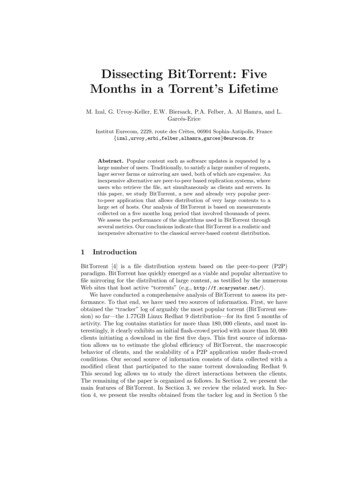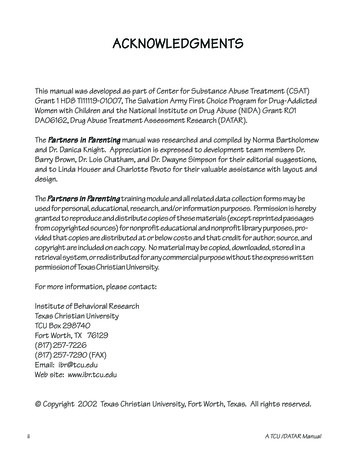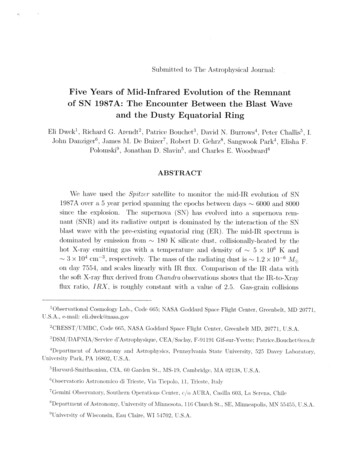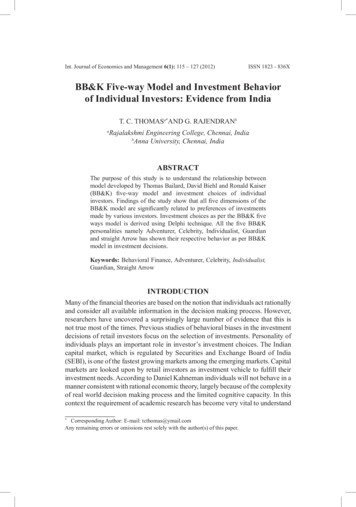
Transcription
Dissecting BitTorrent: FiveMonths in a Torrent’s LifetimeM. Izal, G. Urvoy-Keller, E.W. Biersack, P.A. Felber, A. Al Hamra, and L.Garcés-EriceInstitut Eurecom, 2229, route des Crêtes, 06904 Sophia-Antipolis, com.frAbstract. Popular content such as software updates is requested by alarge number of users. Traditionally, to satisfy a large number of requests,lager server farms or mirroring are used, both of which are expensive. Aninexpensive alternative are peer-to-peer based replication systems, whereusers who retrieve the file, act simultaneously as clients and servers. Inthis paper, we study BitTorrent, a new and already very popular peerto-peer application that allows distribution of very large contents to alarge set of hosts. Our analysis of BitTorrent is based on measurementscollected on a five months long period that involved thousands of peers.We assess the performance of the algorithms used in BitTorrent throughseveral metrics. Our conclusions indicate that BitTorrent is a realistic andinexpensive alternative to the classical server-based content distribution.1IntroductionBitTorrent [4] is a file distribution system based on the peer-to-peer (P2P)paradigm. BitTorrent has quickly emerged as a viable and popular alternative tofile mirroring for the distribution of large content, as testified by the numerousWeb sites that host active “torrents” (e.g., http://f.scarywater.net/).We have conducted a comprehensive analysis of BitTorrent to assess its performance. To that end, we have used two sources of information. First, we haveobtained the “tracker” log of arguably the most popular torrent (BitTorrent session) so far—the 1.77GB Linux Redhat 9 distribution—for its first 5 months ofactivity. The log contains statistics for more than 180, 000 clients, and most interestingly, it clearly exhibits an initial flash-crowd period with more than 50, 000clients initiating a download in the first five days. This first source of information allows us to estimate the global efficiency of BitTorrent, the macroscopicbehavior of clients, and the scalability of a P2P application under flash-crowdconditions. Our second source of information consists of data collected with amodified client that participated to the same torrent downloading Redhat 9.This second log allows us to study the direct interactions between the clients.The remaining of the paper is organized as follows. In Section 2, we present themain features of BitTorrent. In Section 3, we review the related work. In Section 4, we present the results obtained from the tacker log and in Section 5 the
conclusions obtained from our client log. We conclude with future directions inSection 6.2BitTorrentBitTorrent is a P2P application that capitalizes the resources (access bandwidthand disk storage) of peer nodes to efficiently distribute large contents. There isa separate torrent for each file that is distributed. Unlike other well-known P2Papplications, such as Gnutella or Kazaa, which strive to quickly locate hoststhat hold a given file, the sole objective of BitTorrent is to quickly replicate asingle large file to a set of clients. The challenge is thus to maximize the speedof replication.A torrent consists of a central component, called tracker and all the currentlyactive peers. BitTorrent distinguishes between two kinds of peers depending ontheir download status: clients that have already a complete copy of the file andcontinue to serve other peers are called seeds; clients that are still downloadingthe file are called leechers. The tracker is the only centralized component of thesystem. The tracker is not involved in the actual distribution of the file; instead,it keeps meta-information about the peers that are currently active and acts asa rendez-vous point for all the clients of the torrent.A user joins an existing torrent by downloading a torrent file (usually froma Web server), which contains the IP address of the tracker. To initiate a newtorrent, one thus needs at least a Web server that allows to discover the trackerand an initial seed with a complete copy of the file. To update the tracker’sglobal view of the system, active clients periodically (every 30 minutes) reporttheir state to the tracker or when joining or leaving the torrent. Upon joining thetorrent, a new client receives from the tracker a list of active peers to connect to.Typically, the tracker provides 50 peers chosen at random among active peerswhile the client seeks to maintain connections to 20 40 peers. If ever a client failsto maintain at least 20 connections, it recontacts the tracker to obtain additionalpeers. The set of peers to which a client is connected is called its peer set.The clients involved in a torrent cooperate to replicate the file among eachother using swarming techniques: the file is broken into equal size chunks (typically 256kB each) and the clients in a peer set exchange chunks with one another. The swarming technique allows the implementation of parallel download[7] where different chunks are simultaneously downloaded from different clients.Each time a client obtains a new chunk, it informs all the peers it is connectedwith. Interactions between clients are primarily guided by two principles. First,a peer preferentially sends data to peers that reciprocally sent data to him. This“tit-for-tat” strategy is used to encourage cooperation and ban “free-riding” [1].Second, a peer limits the number of peers being served simultaneously to 4 peersand continuously looks for the 4 best downloaders (in terms of the rate achieved)if it is a seed or the 4 best uploaders if it is a leecher.BitTorrent implements these two principles, using a “choke/unchoke” policy.“Choking” is a temporary refusal to upload to a peer. However, the connection
is not closed and the other party might still upload data. A leecher services the 4best uploaders and chokes the other peers. Every 10 seconds, a peer re-evaluatesthe upload rates for all the peers that transfer data to him. There might be morethan 4 peers uploading to him since first, choking is not necessarily reciprocaland second, peers are not synchronized. 1 He then chokes the peer, among thecurrent top 4, with the smallest upload rate if another peer offered a betterupload rate. Also, every 3 rounds, that is every 30 seconds, a peer performs anoptimistic unchoke, and unchokes a peer regardless of the upload rate offered.This allows to discover peers that might offer a better service (upload rate).Seeds essentially apply the same strategy, but based solely on download rates.Thus, seeds always serve the peers to which the download rate is highest.Another important feature of BitTorrent is the chunk selection algorithm.The main objective is to consistently maximize the entropy of each chunk in thetorrent. The heuristic used to achieve this goal is that a peer always seeks toupload the chunk the least duplicated among the chunks it needs in its peer set(keep in mind that peers only have a local view of the torrent). This policy iscalled the rarest first policy. There exists an exception to the rarest first policywhen a peer joins a torrent and has no chunks. Since this peer needs to quicklyobtain a first chunk (through optimistic unckoke), it should not ask for the rarestchunk because few peers hold this chunk. Instead, a newcomer uses a randomfirst policy for the first chunk and then turns to the rarest first policy for thenext ones.3Previous WorkApproaches to replicate contents to a large set of clients can be classified asclient side and server side approaches. The first client-side approach was tocache contents already downloaded by clients of a given network. A symmetricapproach on the server side is to transparently redirect clients to a set of mirrorsites run by a content provider (e.g. Akamai).The peer-to-peer paradigm has been applied to obtain client side and serverside solutions. On the server side, one finds proposals like [5] where overlay nodesdynamically organize themselves so as to form a tree with maximum throughput.FastReplica [2] is designed to efficiently replicate large contents to a set of wellknown and stable overlay nodes.On the client side, one finds many proposals to build application-layer multicast services [8, 6, 3]. A solution similar to BitTorrent is Slurpie [9]. Slurpie aimsat enforcing cooperation among clients to alleviate the load of a Web server thatis the primary source of the content. The algorithms of Slurpie are much morecomplex than the ones of BitTorrent and require to estimate the number of peersin the Slurpie network. The expected improvements over BitTorrent is less loadon the topology server (equivalent to the BitTorrent tracker) and on the primary1For instance, a peer that was offering a very good upload rate has decided to chokethis connection just 1 second before the reevaluation on the other side and thus hemight still be in the top 4 list for the next 10 seconds and received service.
source (original seed) through a back-off algorithm. Results are promising sinceSlurpie is able to outperform BitTorrent in a controlled environment. Still, theactual performance of Slurpie in case of flash crowds and for a large number ofclients is unknown.4Tracker Log AnalysisThe tracker log covers a period of 5 months from April to August 2003. Thecorresponding torrent has as content the 1.77 GB Linux Redhat 9 distribution.180, 000 clients participated to this torrent with a peak of 51, 000 clients duringthe first five days (see Figures 4 and 4). These first five days clearly exhibitsa flash-crowd. As clients periodically report to the tracker their current state,along with the amount of bytes they have uploaded and downloaded, the trackerlog allows us to observe the global evolution of the file replication process amongpeers.45003500300025002000150010005000All peersSEEDSLEECHERS4000Number of peersNumber of peers4500All 1/0906:00030/0324:0031/0324:0001/0424:00Time(a) Complete trace02/0424:0003/0424:00Time(b) Zoom on the first five daysFig. 1. Number of active peers over time4.1Global PerformanceAnalyzing the tracker log, our first finding is that BitTorrent clients are altruisticin the sense that they actively send data to other clients, both as leechers and asseeds. Altruism is enforced during the download phase by the tit-for-tat policy,as a selfish client will be served with a very low priority. Once they becomeseed, the peers remain connected for another six and a half hours on average.This “social” behavior can be explained by two factors: first, the client mustbe explicitly terminated after completion of the download, which might wellhappen while the user is not at his computer, e.g., overnight; second, as the
content being replicated is perfectly legal, the user has no particular incentive toquickly disconnect from the torrent. In fact, the presence of seeds is a key feature,since it greatly enhances the upload capacity of this torrent and the ability toscale to large client populations. Over the 5 months period covered by the logfile, we observed that the seeds have contributed more than twice the amountof data sent by leechers (see Figure 2). We also observed that the proportion ofseeds is consistently higher than 20%, with a peak at 40% during the first 5 days(see Figure 3). This last figure clearly illustrates that BitTorrent can sustaina high flash-crowd since it quickly creates new seeds. To put it differently, insituations where new peers arrive at a high rate, the resources of the system arenot divided evenly between clients, which would result, like in a processor sharingqueue under overload, in no peers completing the download. On the contrary,older peers have a higher priority since they hold more chunks than youngerpeers, which gives them more chance to complete the download and becomeseeds for newcomers. Obviously, this strategy benefits from the cooperation ofusers that let their clients stay as seeds for long periods of time.4e 13100Uploaded by SEEDSUploaded by LEECHERS3.5e 133e 132.5e 132e 131.5e 13LEECHERSSEEDS80PercentageCumulative uploaded bytes4.5e 131e 136040205e 12031/03 01/0501/06 01/0701/08 01/09Time031/0301/0501/0601/0701/0801/09TimeFig. 2. Volumes uploaded by seeds and Fig. 3. Proportions of seeds and leechersleechers4.2Individual Session PerformanceA fundamental performance metric for BitTorrent is the average download rateof leechers. Over the 5 months period covered by the tracker log, we observed anaverage download rate consistently above 500kb/s. This impressive figure indicates that most of the BitTorrent clients have good connectivity (at least ADSL),which is not surprising given the total size of the file. Moreover, BitTorrent exhibits good scalability: during the initial flash-crowd, the average download ratewas close to 600kb/s and the aggregate download rate of all simultaneously activeclients was more than 800Mb/s.BitTorrent is thus able to capitalize the bandwidth of end system hosts toachieve a very high aggregate throughput. Still, the final objective of BitTorrentis to replicate a given content over all the peers in a torrent. We thus need to know
how many peers eventually completed the download and the fraction of bytesthat the peers that did no complete the transfer downloaded. Since BitTorrentallows users to suspend and resume the download at any time, a peer mightcomplete the download after one or several sessions. In the tracker log, a sessionid identifies the session (hash of the IP address of the host and its current time),along with the IP address of the host as seen by the tracker. Thus, identifyingsingle session downloads is easy based on the session id. To reconstruct multisessions downloads, we assumed that the IP address of the host does not changefrom one session to another. NATs often used port number
torrent, one thus needs at least a Web server that allows to discover the tracker and an initial seed with a complete copy of the le. To update the tracker’s global view of the system, active clients periodically (every 30 minutes) report their state to the tracker or when joining or leaving the torrent. Upon joining the torrent, a new client receives from the tracker a list of active peers .











